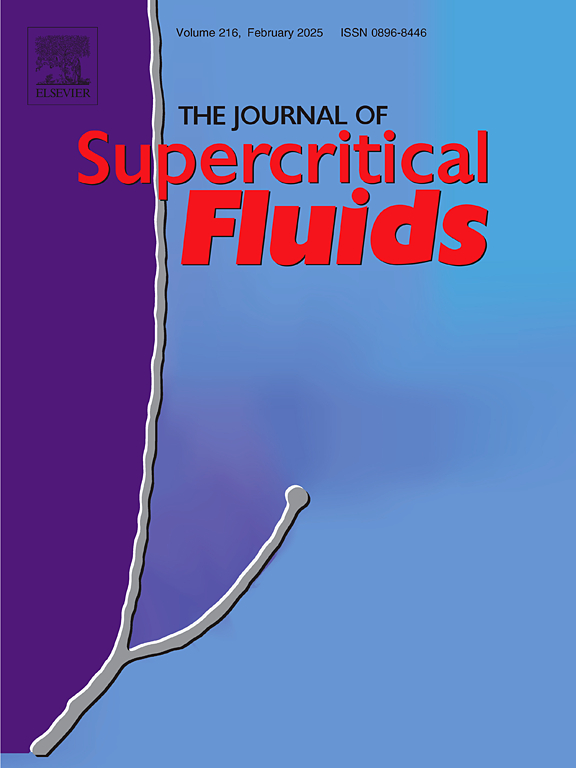超声辅助下槲皮素亚临界水纳米化研究
IF 4.4
3区 工程技术
Q2 CHEMISTRY, PHYSICAL
引用次数: 0
摘要
采用响应面Box-Behnken (BBD)设计优化超声辅助亚临界水(SCW)纳米化制备槲皮素纳米颗粒(nano-QC)。SCW是抗溶剂沉淀(ASP)过程中的溶剂,自变量为SCW温度(120-150℃)、超声功率(0-100 W)和聚乙烯吡罗烷酮(PVP)浓度(0.1-0.5 wt%)。制备平均粒径为17 ± 4 nm,多分散指数(PDI)为0.143 ± 0.022的最佳条件为:超声温度为150℃,超声功率为100 W, PVP浓度为0.3 wt%。并与原料进行了理化性质和抗氧化活性的比较。FTIR结果证实,SCW纳米化后样品没有化学变化。然而,DLS和SEM观察到明显的变化。与原qc相比,纳米qc的溶出率明显提高,抗氧化活性也有所提高。本文章由计算机程序翻译,如有差异,请以英文原文为准。
Ultrasound-assisted subcritical water nanonization of quercetin
The response surface Box-Behnken (BBD) design was applied to optimize quercetin nanoparticle (nano-QC) formation by ultrasound-assisted subcritical water (SCW) nanonization. The SCW was the solvent in an anti-solvent precipitation (ASP) process and independent variables were SCW temperature (120–150°C), ultrasound power (0–100 W), and polyvinylpyrrolidone (PVP) concentration (0.1–0.5 wt%). The optimal conditions for producing the lowest mean particle size of 17 ± 4 nm with polydispersity index (PDI) of 0.143 ± 0.022 were SCW temperature of 150 °C, ultrasound power of 100 W, and PVP concentration of 0.3 wt%. The physicochemical properties and antioxidant activity of the nano-QC were compared to raw-QC. The FTIR results confirmed no chemical changes in the samples after the SCW nanonization. However, significant changes were observed by DLS and SEM. Compared with the raw-QC, the nano-QC showed noticeable increase in dissolution rate and higher antioxidant activity.
求助全文
通过发布文献求助,成功后即可免费获取论文全文。
去求助
来源期刊

Journal of Supercritical Fluids
工程技术-工程:化工
CiteScore
7.60
自引率
10.30%
发文量
236
审稿时长
56 days
期刊介绍:
The Journal of Supercritical Fluids is an international journal devoted to the fundamental and applied aspects of supercritical fluids and processes. Its aim is to provide a focused platform for academic and industrial researchers to report their findings and to have ready access to the advances in this rapidly growing field. Its coverage is multidisciplinary and includes both basic and applied topics.
Thermodynamics and phase equilibria, reaction kinetics and rate processes, thermal and transport properties, and all topics related to processing such as separations (extraction, fractionation, purification, chromatography) nucleation and impregnation are within the scope. Accounts of specific engineering applications such as those encountered in food, fuel, natural products, minerals, pharmaceuticals and polymer industries are included. Topics related to high pressure equipment design, analytical techniques, sensors, and process control methodologies are also within the scope of the journal.
 求助内容:
求助内容: 应助结果提醒方式:
应助结果提醒方式:


